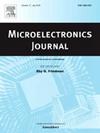Temperature-aware optimal repeater insertion for multilayer graphene nanoribbon interconnects
IF 1.9
3区 工程技术
Q3 ENGINEERING, ELECTRICAL & ELECTRONIC
引用次数: 0
Abstract
In this paper, a temperature-aware power-delay product (PDP) optimization model for repeater insertion in multilayer graphene nanoribbon (MLGNR) interconnects for different technology nodes is presented. The model is solved using the sparrow search algorithm (SSA) to determine the optimal number and size of repeaters for MLGNR interconnects. For comparative analysis, the same optimization procedure is also applied to copper (Cu) interconnects. At room temperature, the optimal repeater metrics including optimal number of repeaters, optimal repeater size, and figure of merit (FoM), are compared between MLGNR and Cu interconnects. It is found that MLGNR interconnects significantly outperform their Cu counterparts, requiring fewer optimal repeaters, smaller optimal repeater size, and yielding a better FoM. In addition, the impact of temperature variation on repeater optimization metrics is investigated for both MLGNR and Cu interconnects. It is demonstrated that elevated temperatures lead to an increase in the optimal number of repeaters up to 23.6 % for Cu and 9.0 % for MLGNR, while the optimal repeater size tends to decrease. The FoM for repeater optimization increases with temperature, showing maximum gains of 23.9 % for Cu and 10.4 % for MLGNR. Also, the effects of electronic Fermi level, edge roughness, contact resistance, and intrinsic parameters (i.e., driver resistance, driver capacitance, and load capacitance) of the minimum-sized gate on repeater optimization metrics are thoroughly examined. Simulation results indicate that enhancing the Fermi level, reducing edge roughness, minimizing contact resistance, and reducing intrinsic parameters of the minimum-sized gate can decrease the FoM and enhance the performance for repeater optimization in MLGNR interconnects.
多层石墨烯纳米带互连的温度感知最佳中继器插入
提出了一种适用于不同技术节点的多层石墨烯纳米带(MLGNR)互连中中继器插入的温度感知功率延迟积(PDP)优化模型。采用麻雀搜索算法(SSA)求解该模型,确定MLGNR互连中中继器的最优数量和大小。为了进行对比分析,同样的优化过程也适用于铜(Cu)互连。在室温下,比较了MLGNR和Cu互连的最佳中继器指标,包括最佳中继器数量、最佳中继器尺寸和优值系数(FoM)。发现MLGNR互连明显优于Cu互连,需要更少的最佳中继器,更小的最佳中继器尺寸,并产生更好的FoM。此外,研究了温度变化对MLGNR和Cu互连中继器优化指标的影响。结果表明,温度升高导致Cu和MLGNR的最佳中继器数分别增加23.6%和9.0%,而最佳中继器尺寸有减小的趋势。中继器优化的FoM随温度的升高而增大,Cu和MLGNR的增益分别为23.9%和10.4%。此外,还研究了最小栅极的电子费米能级、边缘粗糙度、接触电阻和固有参数(即驱动电阻、驱动电容和负载电容)对中继器优化指标的影响。仿真结果表明,提高费米能级、减小边缘粗糙度、减小接触电阻和减小最小尺寸栅极的固有参数可以降低FoM,提高MLGNR互连中继器优化性能。
本文章由计算机程序翻译,如有差异,请以英文原文为准。
求助全文
约1分钟内获得全文
求助全文
来源期刊

Microelectronics Journal
工程技术-工程:电子与电气
CiteScore
4.00
自引率
27.30%
发文量
222
审稿时长
43 days
期刊介绍:
Published since 1969, the Microelectronics Journal is an international forum for the dissemination of research and applications of microelectronic systems, circuits, and emerging technologies. Papers published in the Microelectronics Journal have undergone peer review to ensure originality, relevance, and timeliness. The journal thus provides a worldwide, regular, and comprehensive update on microelectronic circuits and systems.
The Microelectronics Journal invites papers describing significant research and applications in all of the areas listed below. Comprehensive review/survey papers covering recent developments will also be considered. The Microelectronics Journal covers circuits and systems. This topic includes but is not limited to: Analog, digital, mixed, and RF circuits and related design methodologies; Logic, architectural, and system level synthesis; Testing, design for testability, built-in self-test; Area, power, and thermal analysis and design; Mixed-domain simulation and design; Embedded systems; Non-von Neumann computing and related technologies and circuits; Design and test of high complexity systems integration; SoC, NoC, SIP, and NIP design and test; 3-D integration design and analysis; Emerging device technologies and circuits, such as FinFETs, SETs, spintronics, SFQ, MTJ, etc.
Application aspects such as signal and image processing including circuits for cryptography, sensors, and actuators including sensor networks, reliability and quality issues, and economic models are also welcome.
 求助内容:
求助内容: 应助结果提醒方式:
应助结果提醒方式:


